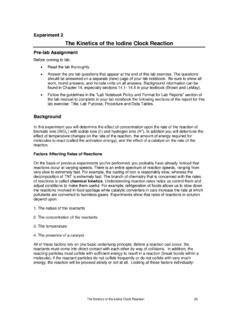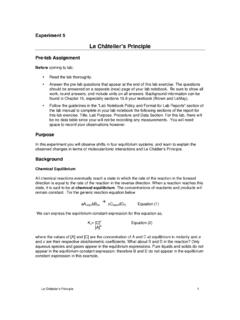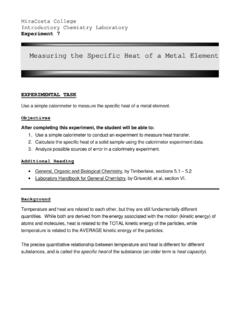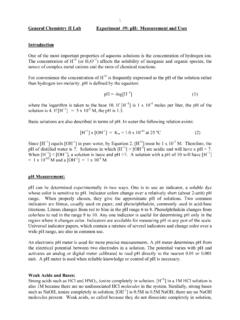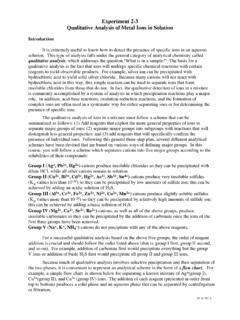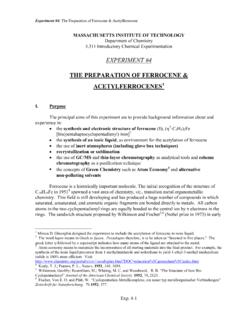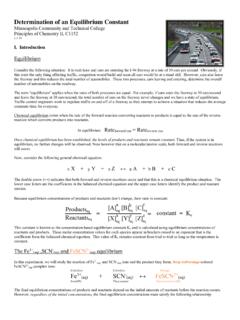Transcription of Synthesis and Analysis of Coordination Compounds
1 Synthesis and Analysis of Cooridnation Compounds 1 experiment 13 Synthesis and Analysis of Coordination Compounds Pre-Lab Assignment Before coming to lab: Read the lab thoroughly. Answer the pre-lab questions that appear at the end of this lab exercise. The questions should be answered on a separate (new) page of your lab notebook. Be sure to show all work, round answers, and include units on all answers. Background information can be found in Chapter 23 in your textbook (Brown and LeMay). Follow the guidelines in the "Lab Notebook Policy and Format for Lab Reports" section of the lab manual to complete in your lab notebook the following sections of the report for this lab exercise: Title, Lab Purpose, Procedure and Data Tables.
2 Purpose In this experiment you will synthesize the Coordination compound tetramminecopper (II) sulfate monohydrate [Cu(NH3)4]SO4 H2O. You will then determine its absorbance curve and compare it to other copper complexes. Finally, you will use spectroscopy to determine the formula of a copper containing Coordination compound . Background Coordination complex Compounds play a vital role in our everyday lives. For example, the molecule heme in the oxygen-bearing protein hemoglobin contains coordinated iron atoms. Chlorophyll, the molecule that enables plants to carry on photosynthesis, is a Coordination compound of magnesium.
3 Coordination complex ions involve a transition metal surrounded by anions and/or neutral molecules called ligands. For example, a Co+3 ion can interact with 6 ammonia molecules forming the complex hexaamminecobalt(III):. The central transition element tends to form 2, 4, or 6 bonds with ligands. The number of bonds formed is called the Coordination number. For example, iron in hemoglobin, cobalt in Vitamin B12, and magnesium in chlorophyll all have Coordination number 6. Copper often has Coordination number 4 while silver and gold can have Coordination number 2. The ligands involved in Coordination Compounds also have their own terminology.
4 Some ligands ( H2O, NH3, amines, halides, nitrite) form only one bond with a metal. We call these Cobalt has a coordiantion number of six in Co(NH3)63+ Synthesis and Analysis of Cooridnation Compounds 2 monodentate (one-tooth) ligands. The formula of a monodentate ligand with a metal having Coordination number 6 would be: MX6 (for example, Co(H2O)6+2 or [Fe(H2O)5Cl]+2 ). Each ligand can bind to one of the 6 possible positions on the metal ion. Other ligands are bidentate (two-toothed) which means they can form two bonds to the central metal ion. Ethylenediamine, commonly abbreviated en , is such a molecule.
5 It contains two nitrogen atoms each of which have lone pairs of electrons which will be attracted to (bond with) the positively charged central metal ion. When ethylenediamine bonds with a metal atom having Coordination number six, the resulting formula with be M(en)3 (for example, Co(en)3+3). This formula indicates that three ethylenediamines bonded to one cobalt ion. Ethylenediamine Chloride ion - a bidentate ligand - a mondentate ion Another example of complex ion using a bidentate ligand would be, Co(en)2Cl2+. Here again, the Coordination number is six . One bond is formed between Co3+ ion and each chloride ion, Cl-, ligand.
6 The remaining four bonds are formed by the two ethylenediamine ligand. Because each en ligand in our Complex is bidentate, two different isomers of the complex are possible; a cis form and a trans form. These are pictured below: In nature, we also find ligands which can form three bonds to the metal ion in the complex (tridentate ligands), for example, diethylenetriamine and or even more than three bonds (polydentate ligands) for example, EDTA. Note that corners in this diagram between the NH2 represent the carbons in the ethylenediamine chain. Synthesis and Analysis of Cooridnation Compounds 3 Synthesis of tetraamminecopper (II) sulfate monohydrate [Cu(NH3)4]SO4 H2O In part A of the lab, we will Synthesis the Coordination compound tetraamminecopper (II) sulfate monohydrate [Cu(NH3)4]SO4 H2O.
7 This will be accomplished by adding concentrated ammonia (NH3) to copper (II) sulfate pentahydrate which will displace the water molecules bound in the original copper complex, and a dramatic color change occurs. The reaction of ammonia with the copper(II) sulfate pentahydrate is a two-step process. In the first step, solid copper (II) hydroxide is formed which is light blue in color. The Cu(OH)2(s) dissolves as additional quantities of ammonia are added in the second step to form the dark blue [Cu(NH3)4]2+ complex. The equations for the process are below Reaction 1: [Cu(H2O)4]SO4 H2O (aq) + 2NH3 (aq) Cu (H2O)2(OH)2]SO4 H2O (s) +2 NH4+(aq) Reaction 2: Cu (H2O)2(OH)2]SO4 H2O (s) + 2 NH4+ (aq) + 2 NH3 (aq) [Cu(NH3)4] SO4 H2O (aq) + 4 H2O (l) The overall net equation for the reaction is Cu(H2O)4]SO4 H2O (aq) + 4 NH3 (aq) [Cu(NH3)4]SO4 H2O + +4 H2O (l) The copper(II) ammonia complex is water-soluble.
8 In order to precipitate and isolate the final product, you need to decrease the solubility of the ionic compound . A convenient way of doing this is to add a large amount of ethanol, CH3CH2OH, to the aqueous solution. Ethanol is much less polar than water, and as the amount of ethanol in the mixture increases, the solubility of ionic Compounds decreases. After the addition of ethanol, your Coordination compound will appear as a crystalline solid. The Synthesis procedure ends with filtration, rinsing, and drying of the product. The next parts of the lab involve Analysis of your copper(II) Coordination compound and comparing it to other copper (II) Coordination Compounds .
9 Your goal will be to make grams of [Cu(NH3)4]SO4 H2O which should be enough to use in next part of the lab. What is tetraamminecopper (II) sulfate monohydrate [Cu(NH3)4]SO4 H2O? The name tetraamminecopper(II) indicates that four ammonia molecules (called ammine in Coordination compound ligo) molecules are covalently bonded to the copper(II) ion. The formula is written [Cu(NH3)4]2+. The square brackets signify that the four ammonia molecules and the Cu2+ ion act as a group, with a +2 charge. This ion will combine with sulfate (SO4 2- ) to make a neutral ionic compound [Cu(NH3)4]SO4. This group will form part of the solid crystal [Cu(NH3)4]SO4 H2O, in which there is one molecule of water forming a hydrated species.
10 Synthesis and Analysis of Cooridnation Compounds 4 Color of complex ions: In part B of the lab you will measure the absorbance spectrum of your product tetraamminecopper (II) sulfate monohydrate [Cu(NH3)4]SO4 H2O and compare it to other copper complexes. Depending on the ligand used to form the complex, the color of a complex ion will vary. The color of a complex is due to an electron in the metal ion absorbs the energy of visible light causing it to "jump" from one energy level to a higher one. This subtracts that color from the visible spectrum as the light is absorbed. For Coordination complexes, the wavelength of light that is absorbed is related to the crystal field splitting energy.
